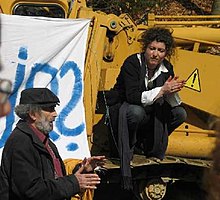Erwin Eisch
| Erwin Eisch | |
|---|---|
 |
|
| Born | 18 April 1927 Frauenau, Germany |
| Nationality | German |
| Other names | E. Eisch |
| Occupation | Artist, educator |
| Known for | Founder, European Studio Glass movement |
Erwin Eisch is a German artist who works with glass. He is also a painter, draughtsman and printmaker. With that of his friend and colleague in glass, Harvey Littleton, Eisch's work in glass embodies the ideas of the international Studio Glass movement. Along with glass artists Sam Herman and Sybren Valkema, Eisch is considered a founder of Studio Glass in Europe.
Erwin Eisch is the eldest of six children of glass engraver Valentin Eisch and his wife, Therese Hirtreiter. The family lived in the town of Frauenau in Bavaria, where Valentin Eisch was employed as a master engraver at the glass factory of Isidor Gistl. The Eisch family was by no means well-off. The elder Eisch supplemented his income by bringing work home to engrave on Sundays. The family also kept a cow, goats and chickens to put milk, eggs and meat on the table.
With Hitler’s rise to power the village of Frauenau, located near the border with Czechoslovakia, suffered under the Nazi regime. According to Erwin Eisch, his family, as well as most of the people in Frauenau, were Communists during the Weimar Republic (1919–1933) and unsympathetic to National Socialism (1933–1945).
Eisch entered the German army in 1945 at age 18. He saw three months of service in Czechoslovakia and Denmark before he was taken prisoner by the British. After an internment of three and a half months, he returned to Frauenau where he learned glass engraving from his father. From 1946 to 1948 Eisch worked at this trade in the family’s cutting and engraving shop while studying at the School of Glassmaking in nearby Zwiesel, Germany (Zwiesel Glasfachschule). After taking his journeyman’s examination in engraving in 1949 Eisch entered the Munich Academy of Fine Arts (Academie der Bildenden Künste). There he studied glass design, sculpture and interior architecture, returning to Frauenau in 1952 to assist his parents and two brothers, Alfons and Erich, in founding a glassworks there. Within a few years the Eisch Glass Factory (Glashütte Eisch) employed a staff of some 200 people.
Eisch returned to the Munich Academy of Fine Arts in 1956, where he continued his studies in sculpture and painting. He, along with other young artists in the late 1950s, was aware of the Tachisme and Art Informel movements. Eisch, however, gravitated toward social criticism and anti-art establishment actions. In 1958 he was a founding member of the artist’s group SPUR at the Munich Academy. Art scholar Susie J.Silbert identified SPUR as a Situationist group intent on revitalizing European culture by emphasizing artistic individualism. Quoting the group's 1958 manifesto, she wrote: "Art relies upon instinct, upon primary creative forces. To the detriment of all intellectual spectators, these free, wild forces always push toward the appearance of new, unexpected forms." Eisch left the group in 1959.
...
Wikipedia
